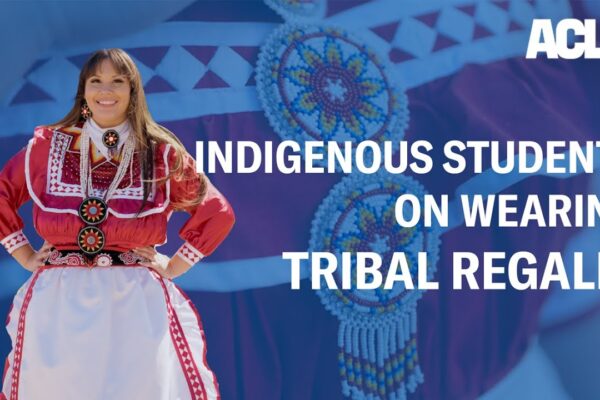Graduation from high school is a pivotal, once-in-a-lifetime achievement. Many Indigenous students cannot fully celebrate this achievement, from both a spiritual and cultural perspective, unless they are permitted to wear their ceremonial tribal regalia (for example, an eagle feather or beadwork on their graduation cap) during the event. Some schools have prohibited Indigenous students from wearing these items at graduation, claiming that it would violate the school’s dress code and speculating, without any basis, that it would disrupt the ceremony. Fortunately, Indigenous students in Arizona’s public and charter schools have rights.
What is tribal regalia?
Tribal regalia are culturally and religiously significant items of dress that are worn by some Indigenous people during traditional ceremonies, activities and important life events, including rites of passage like graduation. Tribal regalia can include a broad range of clothing items, accessories, and adornments.
In the context of high school graduations, some Indigenous students have sought to wear beadwork or an eagle feather on their graduation caps. Others have worn traditional moccasins and leggings, sealskin caps, or leis. Tribal regalia can also include hairstyles such as hair worn long or in braids.
Do Indigenous students have a legal right to wear tribal regalia at graduation ceremonies?
Arizona law protects public and charter school students’ rights to wear tribal regalia at graduation ceremonies as long as the student is enrolled or is eligible to be enrolled in a federally recognized tribe. The Arizona Department of Education’s Office of Indian Education recommends notifying your school that you intend to wear tribal regalia or items of cultural significance before the graduation ceremony. Here is a self-advocacy letter template that can be used to communicate with school principals and district superintendents.
Religious freedom laws in Arizona may offer another source of legal protection for public school Indigenous students who believe that wearing tribal regalia is an important part of their religious or spiritual practice.
The First Amendment to the U.S. Constitution may also provide protections, especially where public schools allow other types of adornment for graduation caps and gowns but prohibit tribal regalia.
In addition, a federal law known as Title VI prohibits federally funded schools (whether public or private) from discriminating based on race, ethnicity, or national origin. Even if schools do not intend to discriminate, if their policies disproportionately and negatively affect students of a particular race, ethnicity, or national origin, the policies will likely be considered discriminatory. School policies that prevent Indigenous students from wearing tribal regalia may violate this law.
What can I do if my public or charter school is refusing to let me wear tribal regalia at graduation?
Indigenous students should be allowed to wear their tribal regalia at graduation. There are ways to fight these unfair restrictions.
Send a letter to your school
You can use our self-advocacy letters to inform school officials of state law and demand that they follow it. Self-advocacy letters are provided for informational purposes only and are not meant to be legal advice or establish an attorney-client relationship.
Even if you do not qualify for protection under an existing tribal regalia law, there are other state and federal laws that may require your school to allow you to wear regalia at graduation. Depending on the circumstances of your situation, you may be able to use one of our other self-advocacy letters to demand that school officials comply with the law.
- If wearing tribal regalia at graduation is an important part of your religious or spiritual practice as an Indigenous person, some states have religious freedom laws or state religious freedom constitutional provisions that provide strong legal protections for your religious exercise.
- Under the First Amendment to the U.S. Constitution, if your school allows graduates to adorn their graduation caps or gowns with other items, or allows other exceptions to the graduation dress code, it may not prevent you from doing the same with tribal regalia.
- If none of the above situations apply to you, you can still send your school a letter explaining the cultural and religious importance of tribal regalia and asking officials to consider giving you an exemption from the graduation dress code.
Contact the Arizona Department of Education's Office of Indian Education
The Office of Indian Education (OIE) administers federal and state programs to meet the educational and cultural needs of Native American students. The office’s Tribal Regalia Graduation Toolkit includes steps students and families can take if their request to wear tribal regalia at graduation is denied.
OIE TRIBAL REGALIA GRADUATION TOOLKIT FOR STUDENTS & FAMILIES
According to their toolkit (page 30), you can email the office at IndianEducation@azed.gov with your contact information, items you plan to wear to graduation, and your school and school district you attend.
File a complaint with the U.S. Department of Education
Title VI prohibits all federally funded schools, whether public or private, from enacting that policies disproportionately and negatively affect students of a particular race, ethnicity, or national origin. If your school has a policy that prevents Indigenous students from wearing tribal regalia, the policy may violate Title VI. Only the U.S. Department of Education can enforce Title VI, but students and parents can file a complaint here.
Why is it important to allow Indigenous students to wear tribal regalia at graduation?
Indigenous students have suffered horrific persecution by the government and education system through numerous attempts to separate Indigenous children from their families and tribes and deny them their rights of cultural and religious expression. For example, through the 1960s, thousands of Indigenous children were forcibly removed from their families and communities to distant, government-run “boarding schools,” where their Indigenous languages, beliefs, and identities were suppressed. These abusive practices created long-lasting, intergenerational trauma in Indigenous communities, which is still felt today.
Denying Indigenous students the right to wear tribal regalia further deprives them of their cultural and religious heritage in the name of assimilation. This adds to the violence and oppression that these students and their communities have already suffered.
Graduation ceremonies are especially meaningful for Indigenous students, who, because of this persecution, have long faced structural barriers and discrimination in educational settings and are thus much less likely to graduate from high school than their peers.
Resources for School Administrators, District Administrators, and Governing Boards
The Arizona Department of Education Office of Indian Education (OIE) administers federal and state programs to meet the educational and cultural needs of Native American students. The office’s Tribal Regalia Graduation Toolkit for School/District Administrators & Governing Boards includes examples of tribal regalia, information about relevant laws and case law, and a checklist to ensure your school or school district understands Indigenous students’ rights regarding tribal regalia.
Stay Informed
Sign up to be the first to hear about how to take action.
By completing this form, I agree to receive occasional emails per the terms of the ACLU’s privacy statement.
By completing this form, I agree to receive occasional emails per the terms of the ACLU’s privacy statement.


